|
|
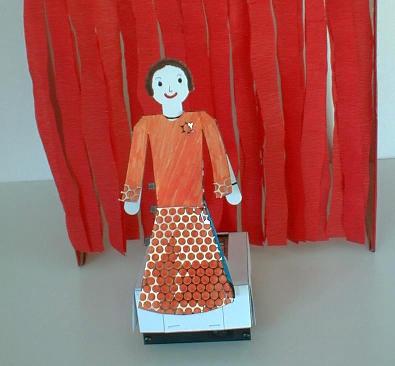
Basic concept
The idea is that the children should design and make outfits for a mannequin. PIXIE moves the mannequin to make the mannequin "strut its stuff" on a catwalk. While PIXIE is moving, the children should read out a prepared commentary to go with the outfit and the movements.
The activity has clear design and technology content and straightforward control content. Speaking and writing however may be the area where many teachers feel that this activity has a large contribution to make.The children have to write a commentary to match the movements of PIXIE. As PIXIE moves at a moderate speed and will normally do a sequence of actions such as showing its left side then its right side, the commentary needs to move on at an appropriate pace and go through similar stages as the program. The children are forced to develop the "plot" of the commentary to match the actions.
After the activity you will have the written work of the commentary together with the matching program and outfit. These should meet any recording requirements you may have.
Link to downloadable resources There are four pages of masters. The cover fits over PIXIE to provide a stand for the mannequin. The mannequins can be used on their own or the outfits can be used to dress them up. The recording sheet allows the program and commentary to be kept together. As well as these sheets you will need to have at least pencils, crayons and scissors. It is a good idea to be aware of how difficult it can be for left-handed children to use normal scissors.You may want to add pieces of material, glue, glitter, sequins etc. if you are feeling brave! The most enthusiastic may want to have materials to make the catwalk etc. A simple sheet of cardboard cut to shape can form the catwalk. You can make a proscenium arch from a cardboard box. One idea is to use thin material glued across the arch and cut into narrow strips so that PIXIE can make an appearance through these "curtains" and retire behind them at the end of the performance.
The first thing to do is photocopy the cover sheet. If you can copy it straight onto card, this is best, alternatively you can copy it onto sticky paper and then stick that to card, or copy onto ordinary paper and then glue that to card. Cornflakes packet card is about the right thickness.
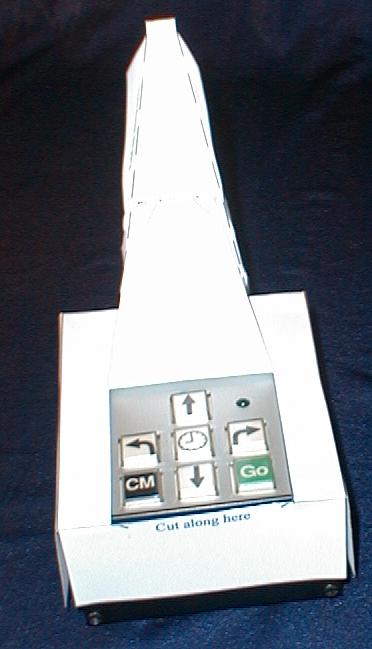
Now you can cut out the two pieces that make the cover. The cover itself is a plain rectangle with four cuts from the outside. There are two triangles to be taken out altogether and a single cut joining the two triangles. Do not cut the base into two parts! The starred area is just to show where the mannequin stand fits.
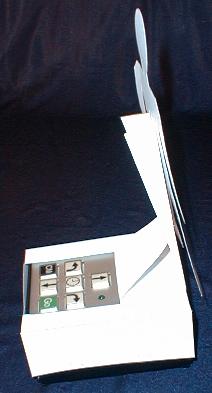
All the folds are "hill" folds back away from the top apart from the front edge of the prop which is a "valley" fold.The mannequin stand is a simple shape to cut out apart from the tab at the top where the mannequin fits. It is best to crush the card along the fold lines with a hard pencil or ball-point pen to make the folding easier. Do not make the folds yet.
You should staple the mannequin stand to the front of PIXIE first and then to the prop. Stapling to the prop is difficult but do not worry too much about appearances, just put a couple of staples there.
Once the mannequin stand is attached, you should make the folds that you scored earlier. These give it a lot of stiffness. The folds are towards the back of PIXIE so that they don't get in the way of the mannequin.
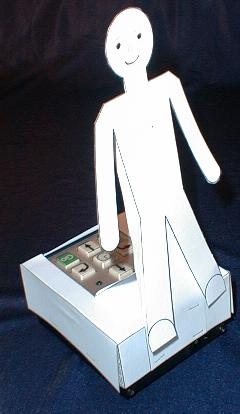
Mannequin
There are two copies on the sheet to make copying quicker. If you want to give the children more cutting-out practice, and save some copying, you could make a master mannequin on cardboard and get them to draw round it and cut that shape out.
You can add a face to the mannequin before copying or you might ask the children to draw the face later.
Cutting out the mannequins should be straightforward. This is the reason it has no fingers, toes or hair! The only problem may be the slot to fit the mannequin to the stand. It may be best for a teacher or clasroom helper to do these with a scalpel. It is a good idea to open up the slot and check that it fits on the stand before starting to dress the mannequin up.
There is no reason why you or the children shouldn't design your own mannequins. They could even be cut-out from a magazine if you get the size roughly right.
The simplest outfit is just to colour-in the mannequin. It is easy for a child to draw a stripey top in one colour and colour-in the legs to make trousers. If you do this, it is best for the children to colour-in the mannequin before cutting it out. This is easier for the child and also gives a better result.
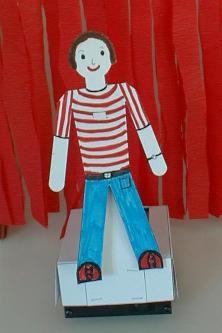
Make sure that the children add things like buttons and belts to get the best effect.You can make this simple outfit much jazzier by sticking things on. Glue and glitter is one approach to making the outfits more attractive.
Another idea would be to stick bits of feather or cloth on. A feather in the hat is easy to do if the hat is just drawn on the mannequin. If you decide to use the clothes on the sheet provided, the children will find them much more difficult to cut out because of the tabs.Remember that tabs can always be taped back on in the event of mishaps!
Like the mannequins, it is easiest to colour-in the clothes before cutting them out.
You are not limited to the shapes as drawn. It is perfectly O.K. to modify the trousers into shorts or make the dress and skirt shorter. The necklines are another area where children can use their design talents. Details such as buttons and belts can be added by drawing. Glitter and applique can also be used to enhance the effect.
You can ask the children to design other types of clothes. For example a sarong should be possible and a sash should be fairly straightforward.
The funny shape in the bottom right-hand corner of the clothes sheet is a hat with a brim. An alternative approach to fitting a hat would be to have two slits in the bottom and fit it over the mannequin's head.
Having thought about the outfits to be shown, the next question is how best to display them. Part of this is the movements that PIXIE should make, part is the commentary that goes along with the movements.
You may find it easiest to start with PIXIE's program. Encourage the children to keep it as simple as possible. A typical program would have PIXIE moving forward, pause, turn to one side then the other and then either back away or turn round and exit. Make sure that the children understand that they will have to write a story to go along with the movements and that the longer the PIXIE program the longer the story they will have to write.Having got an outfit and a "dance", each child will have to write a story to go along with it. The story should include the name of the model, a description of the outfit, both in terms of the types of clothes and the colours.
Brighter children can synchronise things so that when PIXIE turns to the right, they talk about, for example, the watch that the model wears on its left hand.
Children will have to test for themselves that the spoken story takes as long as the program. An ideal story will finish just as PIXIE finishes its dance. Either the dance or the story can be changed to make this happen.
It is important that children record both their program and their story. The sheet provided is an example of how to do it with both the program and the story on one sheet. The full record for one child will also include the outfits and mannequins that they have made.
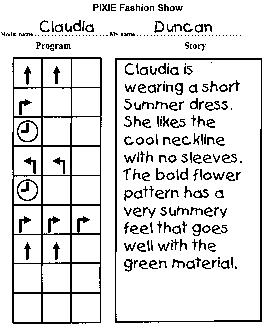
In the example I show a typical program and story. This story is the correct length to go with the program when I read it. Others may read it more or less slowly!
I show rather "posh" symbols for movements and pauses. It should be easy for a child to draw arrows for PIXIE's movements but it may be appropriate either to use a circle for the clock face symbol or a letter "p" for pause.
Apart from the benefits to the teacher of having the child's efforts recorded, the child should use the record to program PIXIE and read out the story as the program is run. It should help the child remember exactly how the performance goes.
It will be also be necessary for the children to write their names on the back of the outfits and mannequins so that you can tell who did what.
For a full fashion show, there will be several models and different outfits. A record of the running order will be needed to allow time for outfits to be changed if one mannequin is used for several outfits. It is also appropriate for all the Summer clothes to be shown together and the Winter outfits at a different time in the show. It is quite an exercise in social skills for the children to negotiate the running order between themselves to get the best overall effect.
There are a few ideas to make the fashion show even more professional. One simple thing is to make an archway for PIXIE to appear and disappear through. This works best with some form of curtains to hide PIXIE until it appears. We made ours out of cardboard covered with bright red sticky-backed plastic. It has narrow coloured crepe paper strips hanging down to make the curtains.
You should consider changing the unit of turn for PIXIE. If you set it to 30o or 45o the movements, you will get a much better effect and the mannequins will be able to stand quarter-faced rather than always full-face or sideways-on.
If you want a bit more "control" content, you could get the children to read their stories into a cassette recorder for replay during the show.
If you have more than one PIXIE, you could have two on the catwalk at once, or you could have one on the catwalk while the other has its mannequin or outfit changed. Coordinating the movements of two PIXIEs is surprisingly difficult to work out.
You may decide that a fashion show is a bit too "girly" for the boys in your class but you can get over this to a large extent by getting them to show football strip for their favourite club.
You could consider doing the same activity as a historical pageant. So, instead of models, you have a Caveman, an Ancient Briton, a Roman, a Saxon, a Viking, a Crusader etc. With this idea, the children's story could be a snippet of history to go with the figure. e.g "Veni, Vidi, Vici" for the Roman, a description of a longboat for the Viking, or a bit of Shakespeare for someone in Elizabethan costume.
Moving from history to geography, you could do a selection of national costumes. The stories would be something about the country's name, what language they speak and how hot/wet/sunny/big it is.
One idea that I would like to try would be a pop music pageant. The mannequins are dressed up as a Teddy Boy, a Hippie, a Glam Rocker, a Punk etc. The "story" is just a few seconds of each of the types of music recorded on a cassette recorder.
If these ideas generate a lot of interest in the theatre, you could go further into this area by getting the children to present "plays". If you have several PIXIEs, they are the characters and the children speak the words to go with the movements. I imagine bits from Shakespeare but I expect that you will get better results from copying the latest soap opera.
It is obviously best if you can get the children to create their own ideas.If you feel really brave, you could try and put on a pantomime complete with "behind you" and "oh no he isn't". This may be particularly appropriate for children with mobility problems who could then put on their own Christmas play using PIXIE with mannequins as the actors.
You might even go as far as using torches for lighting effects. You could use different coloured paper filters in front of the torch to get different effects. You don't have to use speech-based theatre. You could have two PIXIEs doing a "ballet". For this you will definitely need the turn units set to something like 45o.
Another theatrical idea would be for the children to make carnival floats as covers for PIXIE. These can be shown individually mounted on a PIXIE to give movement or they can be linked together with string so that PIXIE can tow several of them.
This will work well with lightweight paper covers as they will just slide on the floor. If the covers are made too heavy, PIXIE will not be able to tow many. This could form the basis of a science experiment to see how many carnival floats PIXIE can tow.
If you decide to do this, you should make the floats quite heavy and experiment yourself before the children have a go. The floats should be of a weight so that PIXIE can only tow three or four of them.


